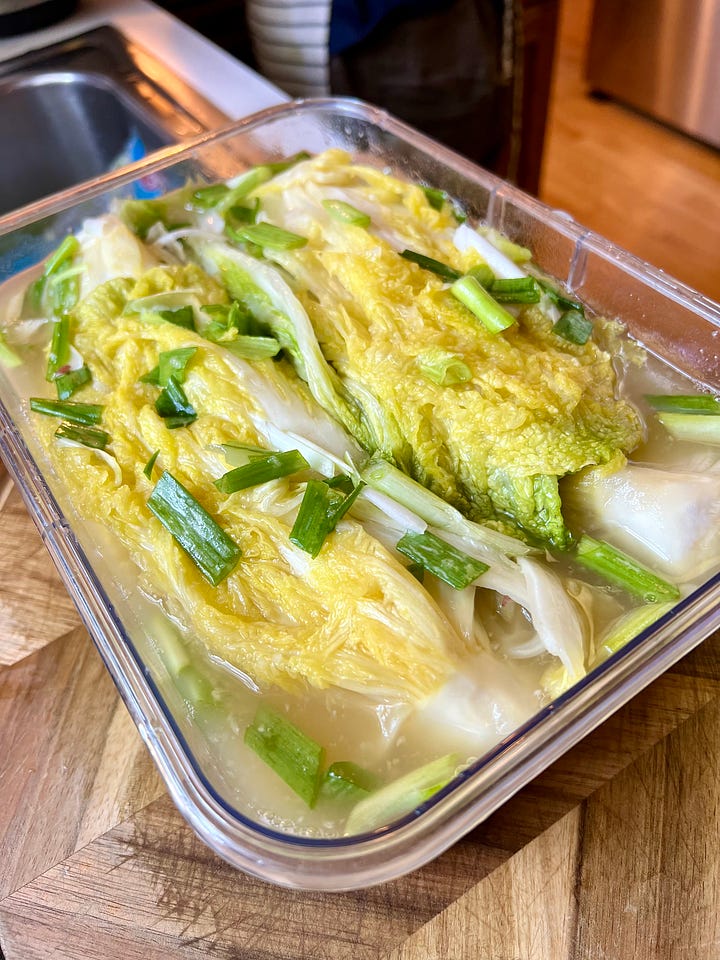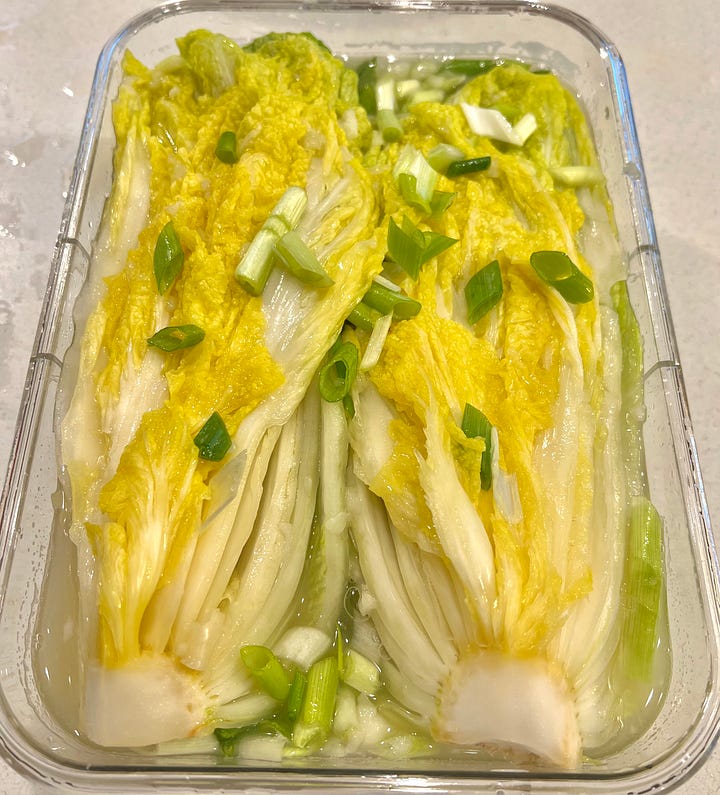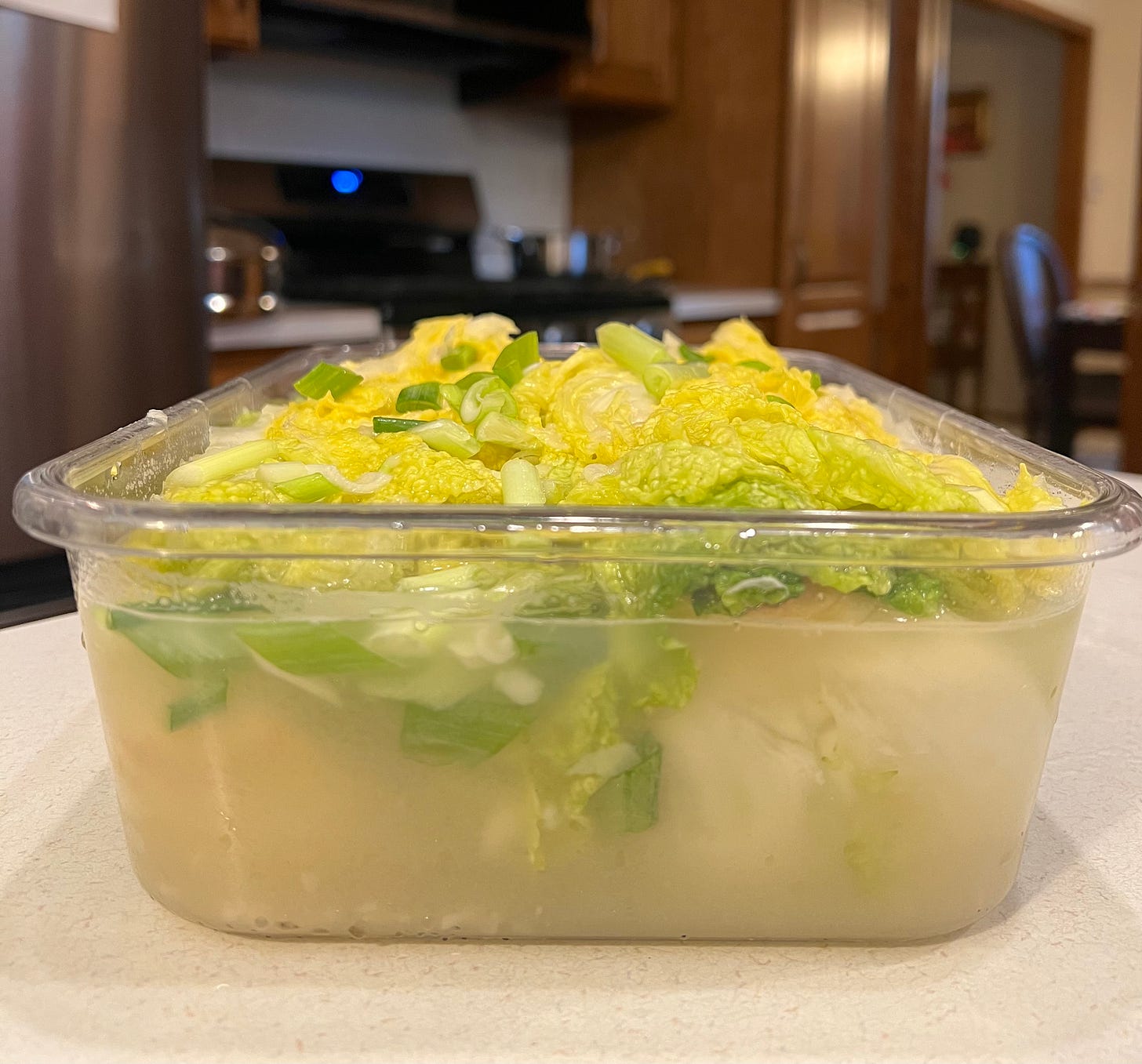My Most Requested Kimchi Recipe: Non-Spicy Kimchi (no peppers)
AKA "White Kimchi" or "Baek-Kimchi" in Korean
If you’ve ever asked me for a non-spicy kimchi recipe (with no peppers), thank you for your patience.
This one took me forever to perfect, and I don’t say that lightly. I wanted it to be as good as the one my mom makes, but also realistic to make without a Korean grocery store nearby. So I tested it with ingredients you can find at Whole Foods (because I want this recipe to be accessible for anyone to try).
So yes, I even used the Whole Foods Napa cabbage (which is smaller and salts a little differently than the massive ones from H Mart).
This is my most requested kimchi recipe ever, and I’m so proud of how it turned out. I tested it more times than I want to admit (our kimchi fridge is basically full of recipe tests of this right now lol).


Let’s just say…
my perfectionist tendencies did not hold back on this one.
I kept tweaking it until it was good enough to share with people who live in LA, Minnesota, or South Dakota. In other words, whether you have access to a Korean market or not, you can make this.
After many bowls of cabbage water and way too much fridge real estate… this is the version that makes me do a little happy dance thinking about you trying it at home hehe (▰˘◡˘▰)
✨ Who This Recipe Is Perfect For
You want a non-spicy kimchi that’s pepper-free
You avoid chili or gochugaru for inflammation or health reasons
You want to introduce probiotics into your (or your kids’) diet
You just want something cold, refreshing, and crunchy in the fridge
You love kimchi and want to try a softer, brighter, more mellow version
🥬 What Makes Baek Kimchi Special
Baek kimchi (백김치) is also called “white kimchi,” a type of kimchi that skips the spicy red pepper flakes and uses ingredients like apple, radish, onion, and garlic to build flavor instead. It’s subtly sweet, a little tangy, super crisp, and naturally probiotic — you know what I always say: eat your skincare!
Also? The broth (aka liquid gold) is elite. Yes, I sip it straight (like all Koreans do). You’ll see why.
📖 What You’ll Get in This Post
A beginner-friendly recipe for baek kimchi made with ingredients from Whole Foods (all linked so you don’t have to guess at the store)
Step-by-step instructions that break down each part of the process (from salting to fermenting)
My exact fermentation timing + storage tips
A Q&A + troubleshooting guide for first-timers
Serving ideas + what to do with that leftover “liquid gold”
Non-Spicy “White Kimchi” Recipe
(all tested — this version was made entirely with Whole Foods ingredients)
🧅 Ingredients
For the cabbage:
1 Napa cabbage (~4 lbs)
¼ cup coarse sea salt (for brine)
¼ cup coarse sea salt (for salting between leaves)
5 cups cold water (for the brine)
For the flour porridge:
1 cup water
1 tbsp all-purpose flour (gluten-free? refer to Q&A section)
For the marinade:
½ lb daikon radish, peeled and chopped
1 red apple (like Fuji, Envy, Honeycrisp), chopped
½ medium sweet onion, chopped
8 garlic cloves
1 tsp ginger
2 cups water
1 tbsp coarse sea salt
1 tbsp anchovy fish sauce (vegan? refer to Q&A section)
To finish:
3 stalks green onion, chopped into ½-inch pieces (split thicker parts first)
🥣 Tools You’ll Need
2 large bowls (for salting + rinsing)
Large strainer (for draining napa cabbage)
Small strainer (for filtering brine)
Whisk
Small saucepan/pot
Food processor/blender
Medium bowl (for marinade brine)
👩🏻🍳 Step-by-Step Instructions
1. Salt the cabbage
Cut a slit into the base of the Napa cabbage, about 3 inches deep, and tear in half. Repeat with each half, cutting a small slit and tearing again to create quarters.
Into a large bowl, mix 5 cups cold water + ¼ cup coarse sea salt. Dunk and swish each cabbage quarter in the brine to coat the leaves.
Sprinkle pinches of the second ¼ cup salt between every 2–3 leaves, focusing on the thick white stems.
Place salted cabbage in a separate large bowl, pour leftover salt water over the top, press down, and cover (it should mostly cover the cabbage).
Let sit 4 hours in summer (6–8 hours in winter) away from direct sunlight. Flip and press halfway through.
2. Rinse & drain
Rinse cabbage 3–4 times in clean water until it tastes pleasantly salty (not harsh). Taste a thick stem to check.
Using a knife, cut out just the tough, thick base of the core (about 1–2 inches), but leave enough so the leaves stay connected at the bottom.
Place the cabbage in a strainer or colander and let it drain well while you prepare the brine.
3. Make the flour porridge
In a small pot, whisk 1 cup water + 1 tbsp flour.
Heat over medium, stirring occasionally to prevent sticking. The mixture will start to thicken as the flour cooks. Once it begins bubbling in the center (~8–9 minutes), reduce the heat to low and cook for another 2 minutes.
Remove from heat and let it cool completely before using.
4. Blend the marinade
Blend 1/2 lb radish, 1 red apple, 1/2 sweet onion, 8 garlic cloves, 1 tsp ginger until smooth.
Into a medium bowl, strain the blended marinade through a cotton cloth/cheesecloth (or fine mesh) to extract a clear, light juice.
Into the medium bowl, whisk in cooled porridge, 2 cups water, 1 tbsp fish sauce, and 1 tbsp salt. The liquid should be slightly beige.
Taste the liquid — it should be slightly savory, slightly sweet, and refreshing. Adjust with a little extra water or salt if needed.
5. Assemble the kimchi
In your container:
Layer 2 cabbage quarters
Sprinkle half the green onions
Add the last 2 quarters
Sprinkle the rest of the green onions
Pour the marinade over, using a strainer to catch any blended solids.
Press cabbage down so it’s submerged.
6. Ferment
Leave at room temperature for 1–2 days, depending on how warm your kitchen is.
You’ll know it’s ready to move to the fridge when:
The cabbage looks more translucent
The brine smells lightly tangy
You see tiny bubbles near the top
Chill and store in the fridge (which will slow down the fermentation process). Best flavor develops between days 3–14.
💬 Q&A + Troubleshooting
First time making kimchi? Or just want to double-check you’re on the right track? Let’s cover the most common questions :)
Q: How do I choose a “good” napa cabbage for kimchi?
The quality of your cabbage makes a big difference in the final flavor and crunch of your kimchi. Here’s what to look for:
Weight: Pick a cabbage that feels heavy for its size — this means it’s packed with tightly layered, juicy leaves.
Shape: Look for a rounded, compact head rather than one that’s loose or elongated.
Leaves: The outer leaves should be crisp and bright green, not wilted or yellowing. The inner leaves should be pale yellow or creamy white.
Stem/Base: The base should look fresh and moist, not dry or browning.
Q: Can I make this vegan or vegetarian?
Yes, with a swap! Traditionally, baek kimchi uses fish sauce for depth of flavor. To make it vegan, substitute fish sauce with soy sauce or coconut aminos. It won’t taste exactly the same but will still be delicious and probiotic-rich! Be sure to taste-test and add more salt/water as needed.
Q: Can I make the flour porridge gluten-free? What can I swap for all-purpose flour?
Yes! You can easily make this recipe gluten-free by swapping the all-purpose flour in the porridge for sweet rice flour (also called glutinous rice flour). It creates the same light, slightly thickened base that helps the flavors cling to the cabbage leaves.
Sweet rice flour is naturally gluten-free and easy to find. It’s sold in Asian markets or often in the Asian section of grocery stores (look for “Mochiko” brand).
Q: How do I know my cabbage is salted enough?
The leaves should feel soft and bendy, not stiff or crunchy. If you can fold the thick white stem without it snapping, it’s ready to rinse.
If it's still stiff: Flip the cabbage, press it down again, and give it another hour.
Q: Can I use table salt?
I recommend coarse sea salt or kosher salt with no additives. Table salt is too fine and can make the cabbage mushy or overly salty.
Q: The marinade tastes too bland/salty before fermenting. What do I do?
Taste it before you pour! If it feels weak, add a touch more salt. If it feels too strong, dilute with a little cold water.
Q: My cabbage fell apart when I cut the stem. Did I ruin it?
Not at all. Just layer the loose leaves into your container and keep going. It’ll ferment the same.
Q: How long should I leave it out before refrigerating?
Summer: 24-36 hours at room temp
Winter: ~48 hours at room temp
Look for small bubbles, a light tangy scent, and slightly translucent leaves.
Q: How long does it keep in the fridge?
At its peak: Days 3–14 (flavor is fresh, lightly tangy, super crisp)
Good to eat: Up to 4–6 weeks in a regular fridge
Even longer: Up to 2 months+ in a dedicated kimchi fridge, as long as it’s submerged in brine and kept airtight
After that, the flavor will become more sour and effervescent (which many people, including me, love), but the texture might soften over time.
Pro tip: Keep cabbage fully submerged in brine and use clean utensils each time to extend freshness!
Q: Can I freeze it?
Not recommended. The texture changes too much so this one’s best enjoyed fresh.
Q: I don’t have a cotton cloth or cheesecloth?
Use a fine mesh strainer and the back of a spoon to press out the juice from your blended marinade.
🍽️ Serving Ideas
Baek kimchi is one of those “goes with everything” banchans. Here’s how my family loves it at home:
With warm rice and a fried egg – my ultimate lazy lunch. The crunchy, tangy cabbage with a runny yolk? Unreal.
Next to grilled or pan-fried meats – pork belly, bulgogi, galbi… it’s the refreshing, juicy bite that cuts through all that richness (because personally, too much meat on its own can feel heavy).
Chopped into salads or grain bowls – think of it like a tangy, probiotic-packed slaw that makes anything less boring.
In sandwiches or wraps – tuck it into a turkey sandwich, wrap, or even tacos for an unexpected crunch.
With noodles – pour the leftover brine over ice, add a splash of water or stock, and you’ve got a cold kimchi noodle broth. So good on hot days.
Straight from the jar – no shame. The brine is basically nature’s sports drink: hydrating, mineral-rich, probiotic-loaded. Kombucha who??💅
More beginner-friendly kimchi recipes you may like :)
Love,
Sparky 🫶




